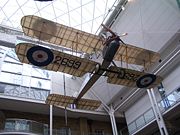
Aircraft dope
Encyclopedia

Plasticizer
Plasticizers or dispersants are additives that increase the plasticity or fluidity of the material to which they are added; these include plastics, cement, concrete, wallboard, and clay. Although the same compounds are often used for both plastics and concretes the desired effects and results are...
lacquer
Lacquer
In a general sense, lacquer is a somewhat imprecise term for a clear or coloured varnish that dries by solvent evaporation and often a curing process as well that produces a hard, durable finish, in any sheen level from ultra matte to high gloss and that can be further polished as required...
that is applied to fabric-covered
Aircraft fabric covering
Aircraft fabric covering is a term used for both the material used and the process of covering aircraft open structures. It is also used for reinforcing closed plywood structures, the de Havilland Mosquito being an example of this technique....
aircraft
Aircraft
An aircraft is a vehicle that is able to fly by gaining support from the air, or, in general, the atmosphere of a planet. An aircraft counters the force of gravity by using either static lift or by using the dynamic lift of an airfoil, or in a few cases the downward thrust from jet engines.Although...
. It tautens and stiffens fabric stretched over airframes and renders them airtight and weatherproof.
Typical doping agents include nitrocellulose
Nitrocellulose
Nitrocellulose is a highly flammable compound formed by nitrating cellulose through exposure to nitric acid or another powerful nitrating agent. When used as a propellant or low-order explosive, it is also known as guncotton...
, cellulose acetate
Cellulose acetate
Cellulose acetate , first prepared in 1865, is the acetate ester of cellulose. Cellulose acetate is used as a film base in photography, as a component in some adhesives, and as a frame material for eyeglasses; it is also used as a synthetic fiber and in the manufacture of cigarette filters and...
and cellulose acetate butyrate. Liquid dopes are highly flammable; nitrocellulose, for instance, is also known as the explosive propellant "guncotton". Dopes will often include colouring pigments to facilitate even application. The colour will usually be red or silver.
Dope has been applied to various aircraft fabrics but typically to Madapolam
Madapolam
Madapolam is a soft cotton fabric manufactured from fine yarns with a dense pick laid out in linen weave. Linen weave is the simplest and thickest interlaced, reversible basic weave, in which the appearance of the face and back of the woven fabric is the same. Its smallest repeat is 2/2, where two...
or fabric with similar fine weave and absorbent qualities. In model aircraft it is often applied to tissue paper.
Non-shrinking dopes (eg banana oil) also exist for uses where tautening is undesirable.
Accidents
Accidents have occurred when dope is not used correctly, for example when mixed with other chemicals, used on the wrong fabrics or applied to contaminated or improperly prepared surfaces.- On 27 April 1995 91-year-old aircraft designer and builder Steve WittmanSteve WittmanSylvester Joseph "Steve" Wittman was an air-racer and aircraft designer and builder.Wittman gained his pilot's license in 1924 in a Standard J-1 and built his first aircraft, the Harley powered "Hardly Abelson" later that same year.From 1925 to 1927 he had his own flying service, giving joyrides...
and his wife were killed when their Wittman O&O Special broke up in flight due to delamination and separation of the wing fabric, resulting in wing aeroelastic flutter. The US National Transportation Safety BoardNational Transportation Safety BoardThe National Transportation Safety Board is an independent U.S. government investigative agency responsible for civil transportation accident investigation. In this role, the NTSB investigates and reports on aviation accidents and incidents, certain types of highway crashes, ship and marine...
stated in their investigation report: "A small section of the wing wood and fabric material was removed for examination. "The examination disclosed that the mahogany plywood had been coated with clear Nitrate Dope". Next, the builder covered the plywood with Stits 150 pound poly-fiber. The builder next brushed a coat of nitrate dope over the layer of poly-fiber followed by a clear coat of butyrate dope. Finally, several coats of poly-spray and yellow poly-tone were sprayed over the coat butyrate dope. According to Mr. Ray Stits, President of Stits Aircraft, the above stated process does not provide the best adhesive qualities. The builder should have first applied two coats of poly-brush on the bare plywood, (see the Poly-Fiber Covering and Painting Manual)."

